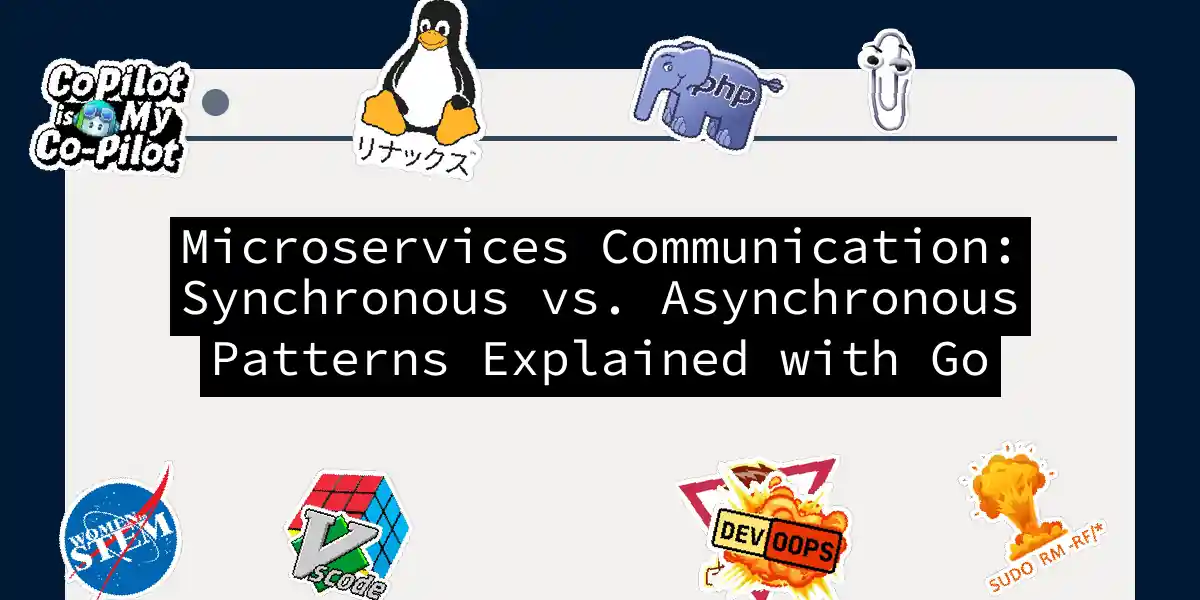When microservices stop talking to each other, your architecture becomes a digital ghost town—and nobody wants to host a server cemetery. Having wrestled with chatty services and silent pods myself, I’ll show you how to master communication patterns without falling into distributed system pitfalls. Let’s get those microservices gossiping like old friends at a pub.
🔄 Synchronous Communication: The Talkative Twins
Imagine two microservices holding walkie-talkies—one shouts, “Hey, need data NOW!” and waits impatiently. That’s synchronous communication. Useful when immediate responses matter, but like overeager toddlers, they can trip over each other.
Client-Side Load Balancing in Go
Here’s a resilient approach using Go’s go-micro framework. Services self-discover their neighbors instead of yelling into the void:
// Service A calling Service B
func CallServiceB(ctx context.Context) (string, error) {
request := &pb.Request{Data: "Ping"}
response := &pb.Response{}
// Create service client
service := micro.NewService()
client := pb.NewServiceBService("serviceB", service.Client())
// Synchronous call with 3-second timeout
if err := client.Call(ctx, request, response, client.WithRequestTimeout(3*time.Second)); err != nil {
return "", fmt.Errorf("Service B ghosted us: %v", err)
}
return response.Result, nil
}
Key takeaway: Timeouts prevent one slowpoke from tanking your entire system.
Circuit Breaker Pattern: The Drama Queen
Services flake out sometimes. Use sony/gobreaker to avoid cascading failures:
cb := gobreaker.NewCircuitBreaker(gobreaker.Settings{
Name: "ServiceC",
Timeout: 5 * time.Second,
ReadyToTrip: func(counts gobreaker.Counts) bool {
return counts.ConsecutiveFailures > 5
},
})
result, err := cb.Execute(func() (interface{}, error) {
return CallServiceC() // Risky operation
})
When ServiceC throws a tantrum, the circuit breaker stops incoming requests like a bouncer at a club.
📨 Asynchronous Communication: The Passive-Aggressive Post-Its
When services communicate via message queues, it’s like leaving sticky notes on a fridge—no immediate response needed. Great for slow tasks or “set it and forget it” operations.
Pub/Sub with Go-Micro
Deploy a RabbitMQ broker, then publish events without waiting:
// Publisher
func OrderCreated(orderID string) {
broker.Publish("orders.created", &OrderEvent{ID: orderID})
}
// Subscriber
broker.Subscribe("orders.created", func(p event.Publication) error {
order := decodeOrder(p.Message().Body)
processOrder(order) // Runs in background
return nil
})
Pro tip: Add dead-letter queues to handle undeliverable messages—because lost notes cause chaos.
🧩 Hybrid Patterns: Best of Both Worlds
API Gateway: The Ultimate Wingman
An API gateway acts like a concierge—clients talk to it, and it routes requests internally. Bonus: It handles authentication and logging while services stay blissfully unaware.
Implementation with Ocelot in .NET or Kong in Go centralizes cross-cutting concerns.
Service Mesh: The Invisible Butler
Linkerd or Istio handle inter-service communication transparently. Add it to Kubernetes via:
linkerd inject deployment.yml | kubectl apply -f -
Now traffic management, retries, and TLS happen automagically—like having a butler clean up after your messy services.
💡 When to Use Which Pattern?
| Scenario | Pattern | Go Tooling | |
|---|---|---|---|
| Payment processing | Sync + Circuit Breaker | gobreaker + go-micro | |
| Order notifications | Async Pub/Sub | RabbitMQ + go-micro | |
| Multi-service requests | API Gateway | Gin + OAuth2 middleware | |
| Legacy integration | REST API (with caution!) | net/http |
Golden rule: Use sync for financial transactions, async for notifications, and never let services gossip directly.
🚀 Step-by-Step: Building Resilient Communication
- Setup Discovery
# Start Consul for service registry consul agent -dev - Implement Circuit Breakers on synchronous calls
- Add Message Brokers for async workflows:
// In microservice config broker := rabbitmq.NewBroker( amqp.URI("amqp://user:pass@localhost:5672") ) - Deploy Service Mesh for production clusters
- Test Failure Scenarios using Chaos Mesh
“Distributed systems are like marionette shows—when one string snaps, you don’t want all puppets collapsing.” – Me, after debugging at 3 AM
⚖️ The Ultimate Tradeoff: Consistency vs. Availability
Synchronous patterns (like two-phase commits) prioritize data consistency—ideal for bank transfers. Asynchronous flows (event sourcing) favor availability—perfect for social media likes. Choose your fighter based on business needs.
When your microservices communicate smoothly, the architecture sings like a well-rehearsed choir. Start with synchronous patterns for critical paths, then offload background tasks to async queues. And remember: services that gossip responsibly build scalable empires! 🚀
